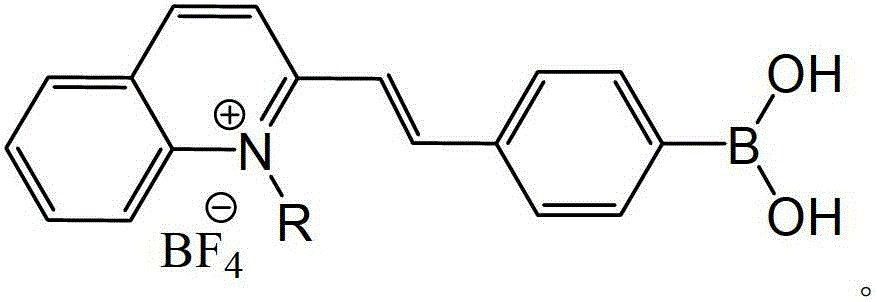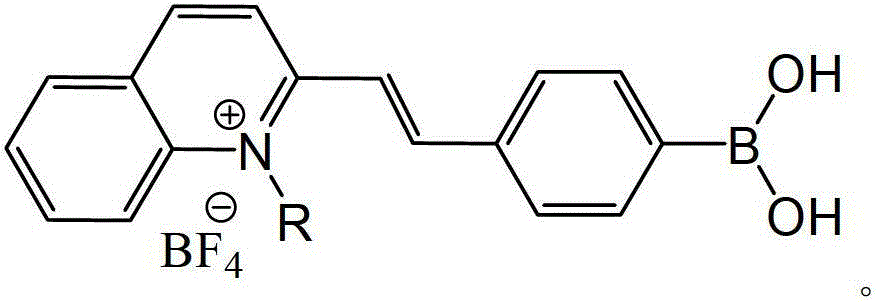Molecular fluorescent probe for detecting hypochlorite and preparation and application thereof
A technology for the detection of hypochlorous acid and fluorescent probes, applied in the directions of fluorescence/phosphorescence, material excitation analysis, chemical instruments and methods, etc., can solve problems such as poor specificity, probe working conditions requiring strong alkalinity, etc., and achieve low cost , The preparation method is simple and easy to implement, and the pH value range is wide.
- Summary
- Abstract
- Description
- Claims
- Application Information
AI Technical Summary
Problems solved by technology
Method used
Image
Examples
Embodiment
[0020] A preparation of a molecular fluorescent probe for detecting hypochlorite, the molecular fluorescent probe is 2-(4-boronic acid phenylvinyl)-N-ethylquinoline borate, the steps are as follows:
[0021] 1) In a nitrogen atmosphere, heat 602 mg (2 mmol) of N-ethyl-2-methylquinoline iodonium salt and 301 mg (2 mmol) of 4-formylphenylboronic acid in 25 ml of solvent absolute ethanol in the dark Reflux reaction, heating temperature is oil bath temperature 100°C, heating and reflux time is 6 hours, and then cooled to 22°C;
[0022] 2) Add 430 mg potassium tetrafluoroborate (KBF 4 ) and stirred for 2 hours, after anion exchange, the crude product was obtained;
[0023] 3) Filter the above crude product to remove inorganic salts, evaporate the solvent from the liquid phase under reduced pressure and concentrate to 5 ml, recrystallize the solid product with 5 ml of absolute ethanol, and obtain 423 mg of a yellow solid product after drying. 2-(4-Boronicophenylvinyl)-N-ethylquino...
PUM
 Login to View More
Login to View More Abstract
Description
Claims
Application Information
 Login to View More
Login to View More - R&D
- Intellectual Property
- Life Sciences
- Materials
- Tech Scout
- Unparalleled Data Quality
- Higher Quality Content
- 60% Fewer Hallucinations
Browse by: Latest US Patents, China's latest patents, Technical Efficacy Thesaurus, Application Domain, Technology Topic, Popular Technical Reports.
© 2025 PatSnap. All rights reserved.Legal|Privacy policy|Modern Slavery Act Transparency Statement|Sitemap|About US| Contact US: help@patsnap.com


